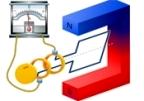Faraday and Electromagnetism
 In 1791, the Italian anatomist Luigi Galvani (1737-98) accidentally discovered that the muscles of a dissected frog contracted if they were simultaneously touched with brass and iron probes. The Italian physicist Alessandro Volta (1745-1827) attributed this effect to the contact of two dissimilar metals.
In 1791, the Italian anatomist Luigi Galvani (1737-98) accidentally discovered that the muscles of a dissected frog contracted if they were simultaneously touched with brass and iron probes. The Italian physicist Alessandro Volta (1745-1827) attributed this effect to the contact of two dissimilar metals.
In 1800, in a letter to the President of the Royal Society, Joseph Banks (1743-1820), Volta announced the creation of a device capable of producing direct electric current. This was the so-called A "voltaic pole" consisting of alternating zinc and copper discs separated by cardboard dividers soaked in salt water.
Scientists immediately realized the importance of this invention. Soon the Englishman Humphrey Davy (1778-1829) developed a more powerful "pillar" called a galvanic battery, which allowed him to isolate for the first time a number of chemical elements: sodium, potassium, magnesium, calcium, strontium and barium. In 1813, Davy accepted a young man named Michael Faraday as an assistant at the Royal Institution.
Faraday, the son of a poor blacksmith, was born on 22 September 1791 in Newington, Surrey.He managed to get only a primary education and at the age of 14 was apprenticed to one of the London bookbinders. The profession of a bookbinder gave the young man the opportunity to read books passing through his hands. Faraday was particularly impressed by the article on electricity in the Encyclopedia Britannica. In 1810 he joined the city's philosophical society, which allowed him to listen to lectures and conduct experiments.
When his apprenticeship ended in 1812, Faraday abandoned his career as a bookbinder. Davy, who was temporarily blind as a result of an explosion in the lab, made him his assistant. In 1813-15 Davy took him on a trip to France and Italy, where they met many eminent scientists, including Volta and Ampère.
Electricity and magnetism
In 1820, the Danish physicist Hans Oersted (1777-1851) discovered that an electric current flowing through a wire deflected a compass needle. This discovery aroused great interest, and soon in Paris Andre Ampere (1775-1836), seeing a demonstration of this experiment conducted by his compatriot François Arago (1786-1853), set about creating a fundamental theory of electromagnetism.
Ampere found that wires carrying currents in the same direction attract, wires carrying opposite currents repel, and a coil of wire through which current flows (he calls it a solenoid) behaves like a magnet. He also proposed using the deflection of a nearby magnetic needle to measure the magnitude of the current—an idea that soon led to the invention of the galvanometer.
At that time, Faraday expressed the idea that closed lines of force form around a current-carrying conductor. In October 1821he creates a device that demonstrates the rotation of a magnet around a current-carrying wire or a wire around a stationary magnet. This was the first conversion of electrical energy into mechanical energy.
Current generation
Without stopping chemical research, Faraday found out how an electric current could be created using a magnetic field. He made this discovery in August 1831 almost by accident.
Trying to discover the relationship between a magnetic field and an electric current, he wound two coils around an iron rod, then connected one of them to a battery to create a magnetic field, and closed the other through a galvanometer. While current was flowing in the first coil, nothing did not happen, but Faraday noticed that the needle of the galvanometer twitched the moment the current appeared or disappeared in the first coil. He concluded that the current causes a change in the magnetic field.
In 1824, Arago noticed that the rotation of the copper disk deflected the compass needle located above it. The reason for this effect was not known. Faraday believed that the rotation of the disc in a magnetic field caused an electric current to be generated in it, which in turn created a magnetic field that deflected the needle.
In October 1831, he constructed a similar device in which a copper disk rotated between the poles of a horseshoe magnet.
The center and edge of the disk were connected to a galvanometer which indicated the flow of direct current. Three months after this discovery, Faraday invented a transformer and electric generator, the design of which has not changed radically to this day.
Laws of electrolysis
Faraday was able to apply his knowledge of electricity to chemistry by formulating the basic laws of electrolysis.He introduced the terms "anode", "cathode", "cation", "electrode" and "electrolyte" into scientific use. After studying electrostatic discharges, he showed that they represent a short-lived electric current.
In 1839, Faraday's health deteriorated and he stopped research work, but in 1845 he resumed it, being interested in the effect of a magnetic field on polarized light. He discovered that a powerful electromagnet could be used to rotate the plane of polarization. This led him to create the electromagnetic theory of light, which was later formulated in mathematical form by James Clerk Maxwell (1831-79).
Faraday ceased working at the Royal Institution in 1862, after which he lived in seclusion in the rooms granted to him by Queen Victoria at Hampton Court Palace, where he died on 25 August 1867.
